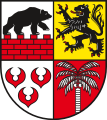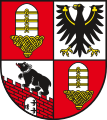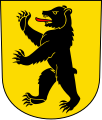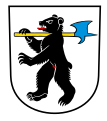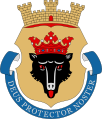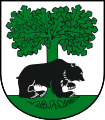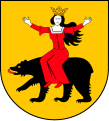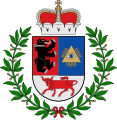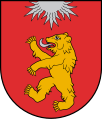Bear in heraldry

Thebearasheraldic chargeis not as widely used as thelion,boaror other beasts.
In England it occurs mostly incanting arms,e.g. in the familial coats of arms of Barnard, Baring, Barnes, Bearsley, etc. In British and Irish heraldry, a bear's head is usually muzzled (reflecting the lack of wild bears in those islands), and is more commonly used as a charge than the whole beast. In England and Ireland, the bear's head traditionally includes the neck, while in Scottish heraldry bear heads are cut off close behind the ears.[1]
The bear in thecoat of arms of Berlinis also used cantingly, and appears in representations of the Berlin coats of arms in theearly modern period(used alongside thePrussianandBrandenburg eaglesuntil the early 20th century).[2]Also canting, but associated with a legendaryfalse etymologyof the city's name, is the bear in the coat of arms ofBern.[a]

At theBattle of Las Navas de Tolosain 1212 betweenAlfonso VIII of Castileand theAlmohads,the council ofMadridsent a detachment in support of the Christian king. According to chronicles of the time, these troops carried a flag or banner which identified them: a statant bear on a silver field.
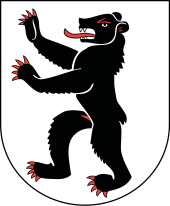
The bear is also used in arms representingSaint Gall,based on a legend of the saint involving a bear.[3] This is the origin of the bear in the coat of arms in theAbbey of Saint Galland ofAppenzell.The bear of Appenzell is representedpizzled;omission of the bear's penis from the coat of arms of Appenzell was seen as a grave insult, and was notoriously forgotten by the printer of a calendar printed inSaint Gallen1579, which brought Appenzell to the brink of war with Saint Gallen.[4][5][6]
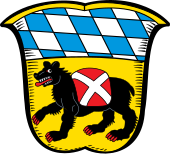
The saddled bear ofSaint Corbinian's legend is the heraldic symbol ofFreising,Bavaria, and theDiocese of Munich and Freising.Pope Benedict XVI,former archbishop ofMunich,also applied it in hisPapal Arms.

In 1666 apolar bearon a blue field was added to thegreater/royal arms of the king of Denmarkto representGreenland.It has since then been adopted by Greenland itself asits coat of arms,with the current version having been adopted in 1989. The Greenlandic version bucks European heraldic tradition in favour of Inuit custom by having the bear's left arm raised rather than the right; when used in Denmark the right is raised. It is officially blazonedAzure, a polar bear rampant argentand as such neither version contradicts the other.
Modern civic and provincial heraldry[edit]
A demi bear appears in the crest of Lawson in Canada.[7]A grizzly bear, with wings, appears as a supporter in the bearings of Norris, also in Canada.[8]Canada has armigers with polar bears in their bearings.[9]Chimerical half-bear, half-ravens appear as supporters of theCanadian Heraldic Authority.
Civic heraldry inWarwickshireabounds in bears.[10]A bear is also used, cantingly, in the arms of theBerwick-upon-Tweed BoroughCouncil.
The coat of arms of German state ofSaxony-Anhaltdepicts a bear on a red city gate on lower half, which is inherited from the formerFree State of Anhalt.This is also adopted by arms of several districts of the state for their histories with Anhalt.
Russian bears(brown bears) and polar bears appear on the coats of arms and flags of numerousRussian federal subjectsand cities, including theRepublic of Karelia,theMari El Republic,the city ofVeliky NovgorodandNovgorod Oblast,theYaroslavl Oblast,Khabarovsk Krai,Perm Krai,Zheleznogorsk,Baltasinsky District,theChukotka Autonomous Okrug,and theYamalo-Nenets Autonomous Okrug.
TheFinnish regionofSatakuntaand thecorresponding historical provincefeature a crowned sword-wielding bear on their coats of arms.Pori,Satakunta's capital, features a crowned bear's head on its arms.
Thecoat of arms of Madriddepicts a bear reaching up into a madroño or strawberry tree (Arbutus unedo) to eat some of its fruit.
Thecoat of arms of Carpathian Ukraine,which features a red bear, is used as the coat of arms of the UkrainianZakarpattia Oblast;it was formerly used bySubcarpathian Ruthenia,the oblast's predecessor withinCzechoslovakia.
A black bear appears on the coat of arms (and flag) ofPrzemyśl,Poland.
A black bear with silver claws and a collar appears on the coat of arms ofSamogitia,a cultural region of Lithuania, and the coat of arms ofŠiauliai,the capital city of LithuanianŠiauliai County.
-
The coat of arms ofAnhalt-Bitterfeld,Saxony-Anhalt
-
The coat of arms ofSalzland,Saxony-Anhalt
-
Coat of arms ofBrigachtal,Baden-Württemberg
-
Coat of arms ofSingen,Baden-Württemberg
-
Coat of arms ofAndeer,Switzerland
-
Coat of arms ofAuswil,Switzerland
-
Coat of arms ofBäretswil,Switzerland
-
Coat of arms ofBühler,Switzerland
-
Coat of arms ofSt Gallen,Switzerland
-
Coat of arms ofHerisau,Switzerland
-
Coat of arms ofSpeicher, Switzerland
-
Coat of arms ofWaldstatt,Switzerland
-
Coat of arms ofOttnang am Hausruck,Austria
-
Coat of arms ofObertraun,Austria
-
The coat of arms of the unrecognisedRepublic of East Karelia (1918–1922)
-
The coat of arms of theRepublic of Karelia
-
The coat of arms of the Mari El Republic
-
The coat of arms ofVeliky Novgorod
-
The coat of arms of the Yaroslavl Oblast
-
The coat of arms ofKhabarovsk Krai
-
The coat of arms ofKhabarovsk
-
The coat of arms of Perm Krai
-
The coat of arms of the Chukotka Autonomous Okrug
-
The coat of arms of theYamalo-Nenets Autonomous Okrug
-
The coat of arms ofZheleznogorsk, Krasnoyarsk Krai.Town was established for the production ofplutonium.
-
The coat of arms ofBaltasinsky district,Tatarstan
-
The coat of arms ofChernyakhovsk,Kaliningrad Oblast
-
The coat of arms ofSatakunta,Finland
-
The coat of arms ofPori,Satakunta, Finland
-
Thecoat of arms of Zakarpattia Oblast,Ukraine
-
The coat of arms ofBarwice,Poland
-
The coat of arms ofChełm,Poland
-
The coat of arms ofOżarów,Poland
-
The coat of arms ofPrzemyśl,Poland
-
The coat of arms ofWęgrów,Poland
-
The coat of arms ofSamogitia,Lithuania
-
The coat of arms ofŠiauliai,Lithuania
-
The coat of arms ofŠiauliai District Municipality
-
The coat of arms ofŠiauliai County
-
The coat of arms ofTelšiai County
-
The coat of arms ofBatakiai,Lithuania
-
The coat of arms ofBartninkai,Lithuania
-
The coat of arms ofMosėdis,Lithuania
-
The coat of arms ofPärnu County,Estonia
-
The coat of arms ofOtepää Parish,Estonia
-
The coat of arms ofValka Municipality,Latvia
See also[edit]
Notes[edit]
- a.^The bear was the heraldic animal of the seal and coat of arms of Bern from the 1220s, attested shortly after its foundation byBerchtold V, Duke of Zähringenin 1191.Swiss chroniclesare unanimous in deriving the name of the city from the name of the animal; modern historiography has long assumed, however, that the city had been named forVerona,until the discovery of theBern zinc tabletin the 1980s, which suggested that the toponymy is of Celtic origin.[11]
References[edit]
- ^Arthur Charles Fox-Davies,A Complete Guide to Heraldry,London (1909),p. 198
- ^Werner Vogel, Berlin und seine Wappen. Ullstein, Berlin 1987
- ^"St Gall's Bear".carnalea.down.anglican.org.
- ^Neubecker, Ottfried (1976).Heraldry: sources, symbols, and meaning.New York: McGraw-Hill. p. 120.ISBN9780070463080.
- ^Strehler, Hermann (1965). "Das Churer Missale von 1589".Gutenberg-Jahrbuch.40:186.
- ^Grzimek, Bernhard (1972).Grzimek's Animal life encyclopedia.Vol. 12. New York: Van Nostrand Reinhold Co. p. 119.
- ^"Archived copy".Archived fromthe originalon 2010-10-30.Retrieved2010-06-12.
{{cite web}}:CS1 maint: archived copy as title (link) - ^"RHSC Roll of Arms: Norris".Archived fromthe originalon 2012-02-12.Retrieved2010-06-12.
- ^Arms of Sylvain BissonnetteofSaint-Bruno, Quebec
- ^"Civic Heraldry of England and Wales-Warwickshire".
- ^Andres Kristol (ed.): Lexikon der schweizerischen Gemeindenamen. Huber, Frauenfeld 2005,ISBN3-7193-1308-5,p. 143.




